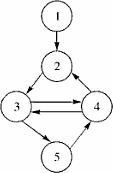In linked lists there are no NULL links in
In a balance binary tree the height of two sub trees of every node can...
An algorithm consists of two modules X1, X2. Their order is f(n) and...
A queue has configuration a,b,c,d. To get configuration d,c,b,a. One...
Number of possible ordered trees with 3 nodes A,B,C is
The centricity of node labeled 5 is
Arranging a pack of cards by picking one by one is an example of
To arrange a binary tree in ascending order we need
IThe dummy header in linked list contain
In above question average access time will be
Number of swapping, operations need to sort numbers 8, 22, 7, 9, 31,...
A sorting technique which guarrantees that records with same primary...
Hash function f is defined as f(key) = key mod 7. If linear probing is...
Which algorithm solves all pair shortest path problem
The result of evaluating prefix expression */b+0dacd, where a=3, b=6,...
In the following tree:
...
A hash tabale with 10 buckets with one slot per bucket is depicted in...
Which of the following is correct
The advantage of sparse matrix linked list representationn over dope...
If yyy, xxx and zzz are the elements of a lexically ordered binary...
If the out degree of every node is exactly equal to M or 0 and the num...
Running time T(n), where 'n' is input size of recursive algorithm is...
The information about an array used in a program will be stored in
If the address of (I,J)th entry, in dope vector representation, where...
Consider two sorted lists of size L1, L2. Number of comparisions...
A binary tree in which every non-leaf node has non-empty left and...
To arrange the books of library the best method is
The average number of comparisions performed by merge sort alrotithm...
In array representation of binary tree teh right child of root will be...
Running time of an algorithm T(n), where n is input size is given by...
In evaluating arithmatic expression 2*3-(4+5) using postfix stack...
The order of an algorithm that finds whether a given boolean function...
In which of the following cases linked list implementaion of sparse...
Write the output of following program:int a[ ] = {1,2,3,} *p;
Four altorithm A1, A2, A3, A4 solves a problem with order log(n), log...
Which of the following algorithm has n log (n) time complexity
Time complexity of an algorithm T(n), where n is the input size is...
The order of binary search algorithm is
Depth of a binary tree with n node is
Average successful search time taken by binary search on sorted array...
In a stack the command to access nth element from the top of the stack...
If the following tree is used for sorting then a new number 10 should...
If running time of an algorithm is given by T(n) = T(n-1) + T(n-2) +...
6 files X1, X2, X3, X4, X5, X6 have 150, 250, 55, 85, 125, 175 number...
Bib O notation w.r.t algorithm signifies
A text is made up of five characters, T1, T2, T3, T4, T5. The...
Average successful search time for sequential search on 'n' item...
The total number of comparisons in a bubble sort is
Following sequence of operation is performed on a stack. Push(1),...
On which principle does stack work?

















